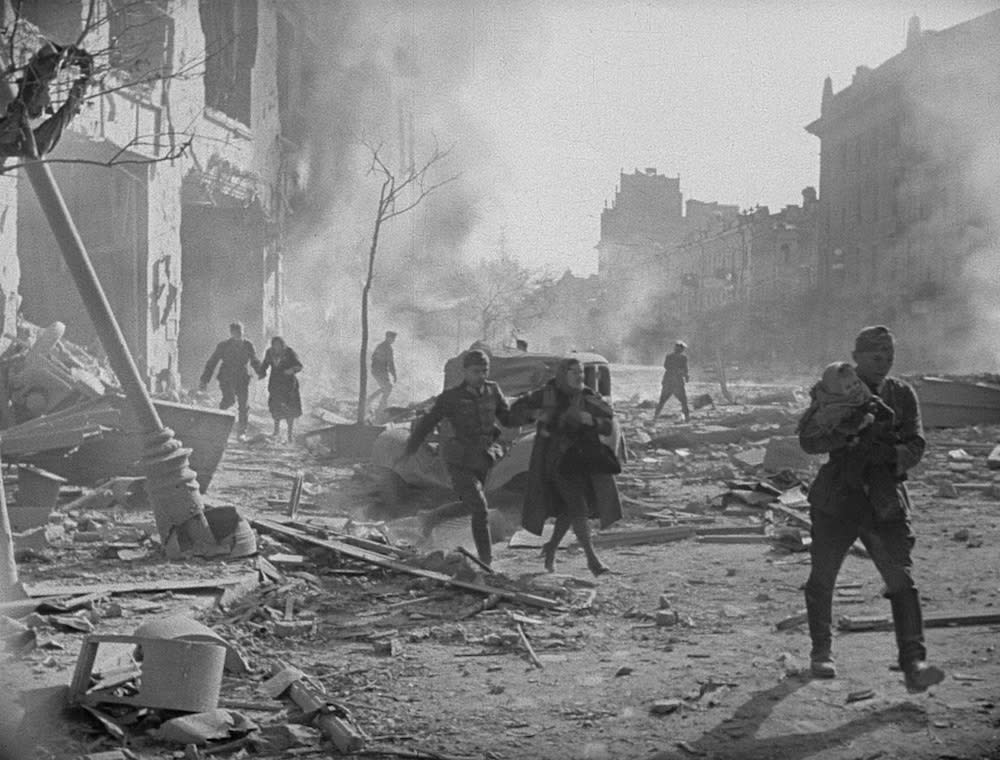Sergei Loznitsa grappling with a heinous massacre
[ad_1]
The first thing one notices when going to Babi Yar is how close the ravine is to Kiev. So close that if the wind was good in those last days of September 1941, the townspeople would almost certainly have heard the gunshots as Nazi soldiers slaughtered 33,771 Jews. Standing on the site, one wonders if the cries would not have been so carried away by the breeze; if so, the cries of terror were largely greeted with shrugs or closed ears. This unfathomable indifference to human life is what “Babi Yar. Context â€is meant to tackle, not as a way to tackle such incomprehensible amorality – there is no way to really explain an atrocity – but to raise awareness, to ensure that the memory of this event was not covered up like the ravine itself was after the war, when it became a troublesome reminder of active and passive anti-Semitism.
Loznitsa’s best documentaries masterfully use archival footage whose tight focus, usually over a few days, allows us to watch the story unfold in stunning and relentless detail. “State Funeralâ€, “The Event†and “Maidan†cover brief periods of time and yet their effect is of historic magnitude, forcing us to confront history through a brilliantly edited prism of repurposed images. , in large part because its duration here is considerably longer, and the focus suffers as a result. The Babi Yar massacre undoubtedly needs context, and the film has more title boxes than most of Loznitsa’s works, but covering the entire period from the Nazi invasion of Ukraine to the years 1950, he makes the massacre part of a puzzle. It can be argued that indeed that was what it was, and yet by presenting the event in this way, without its usual laser-sharpened gaze, the genocidal horror simply becomes part of the war machine, its impact on the local population is just another aspect of the Occupation.
More Variety
When the Nazis invaded Soviet Ukraine in June 1941, many residents, especially those in the western part who were under Austro-Hungarian control until the end of World War I, greeted the incoming troops with cheers. . Objectively, it’s not hard to see why: Stalin’s murderous agricultural policies resulted in the deaths of millions of people, so it’s no wonder that large swathes of the population treated the Germans as liberators. If you weren’t directly related to the Soviet administration and weren’t Jewish, you could reasonably assume that you would be better off under the Nazis.
Once the bloody battles for control of the territory were over, it became easy to label the Jews as fifth columnists and Soviet sympathizers; Loznitsa discovered deeply disturbing images of people in Lviv (formerly Lemberg) being beaten, stripped naked and dragged through the streets by their neighbors, the poor quality of the images somehow increasing their power. In September, Kiev was taken after fierce fighting that destroyed parts of the city, and once again Jews became a convenient scapegoat for occupiers and locals alike. They were rounded up and taken to the Babi Yar ravine on the outskirts of the city where, between September 29 and September 30, more than 33,000 people were shot dead.
Loznitsa incorporates more photos than maybe in any of his other documentaries: half-buried bodies, shoes, fallen snaps of lifeless hands, even a prosthetic leg separated from its owner’s limb. One of the local newspapers celebrated his liberation from the “Eastern barbarians”. The following month there was a big parade – the word cold is too sweet to describe the feel of a city celebrating just weeks after tens of thousands of citizens were so quickly wiped out. Indifference continues to shock.
In November 1943, the Soviets recaptured Kiev, their soldiers (at least in the images seen here) greeted with resignation, unlike Nazi troops a few years earlier who had flowers thrown at their feet as crowds rushed for flags to Miniature swastikas and “Hitler’s Liberator posters.†In the same month, international journalists were taken to Babi Yar and in January 1946 the trials began. The film included footage from the court, not only the well-known testimony of the actress Dina Pronicheva, one of the few survivors of the massacre, literally climbing through the air under piles of corpses, but also SS soldier Hans Isenmann, whose surprisingly devoid of emotion statement demonstrates the mechanical nature of the massacre.
Loznitsa shows the execution by hanging that ended the trial, the 13 men seen from relatively close up in their final death shudder. Is it hypocritical to ask why such close graphic images have been included when we are not asking why we are seeing the corpses of soldiers and victims of atrocities? All death is ugly and brutal, but the act of killing is something apart, and in this case, it might not have been shown better than in the longer shots. A few years later, the memory of the massacre became an inconvenience, an annoyance given the number of residents who turned a blind eye, and in 1952 the city council authorized the filling of the ravine with industrial waste. Now the area is wooded apart from a few unimpressive monuments, a place for joggers and wild dogs.
Babi Yar has been tackled in a movie before, but never by someone of Loznitsa’s caliber. For this reason, one expects something more powerful, more revealing in the way he presents the building blocks of evil. “Babi Yar. Context†does as the title suggests: it gives context, meaning it doesn’t remove accretions from the background and the afterlife. Maybe watch exclusively in this terrifying heart of darkness was just too much for the filmmaker to face – it’s hard to find a sense of direction when trying to figure out how 33,771 people were put down in two days, and so few bothered to notice it.
The best of variety
Sign up for the Variety newsletter. For the latest news, follow us on Facebook, Twitter and Instagram.
[ad_2]

